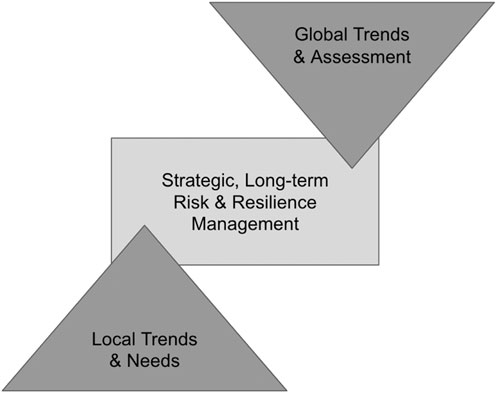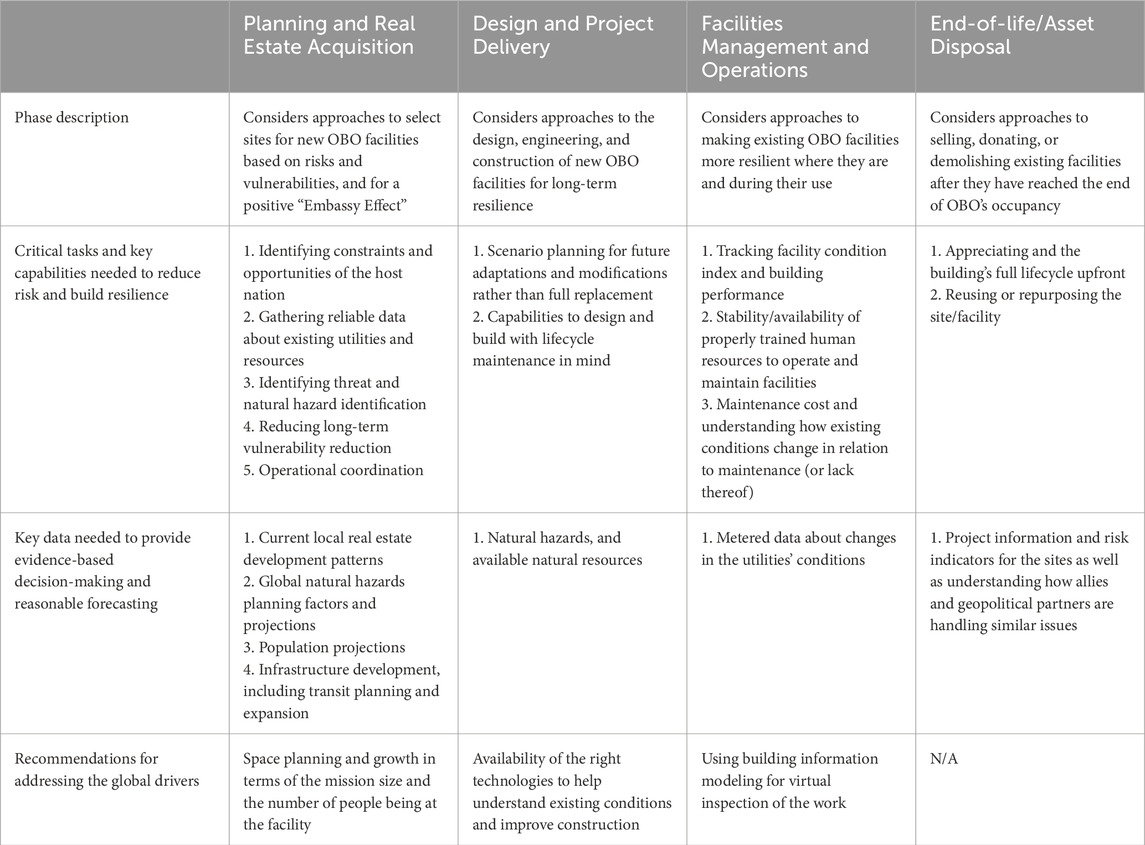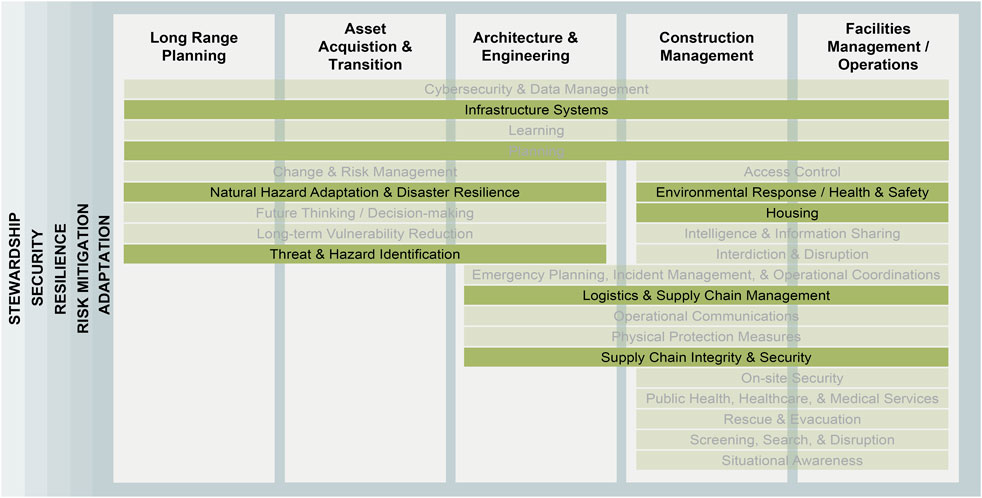- 1College of Engineering, University of Georgia, Athens, GA, United States
- 2Center for Emergency Management Homeland Security, School of Public Affairs, Arizona State University, Phoenix, AZ, United States
- 3Center of Building Innovation, Arizona State University, Tempe, AZ, United States
- 4School of Sustainable Engineering and the Built Environment, Arizona State University, Tempe, AZ, United States
- 5School of Geographical Sciences and Urban Planning, Arizona State University, Tempe, AZ, United States
- 6Urban Climate Research Center, Arizona State University, Tempe, AZ, United States
- 7Julie Ann Wrigley Global Futures Laboratory, Arizona State University, Tempe, AZ, United States
To account for increasing complexity and uncertainty in environmental, social, and technological systems, organizations that manage risk and vulnerability while maintaining large physical asset or infrastructure projects must identify, inventory, and anticipate trade-offs across multiple drivers of change. This article describes an integrated and inclusive process to develop a capabilities-based planning (CBP) framework to inform decision-making for future investments, centering hazard risk reduction and operational resilience. The proposed CBP framework demonstrates an approach to addressing context-specific complexity and uncertainty in decision-making by assessing short and long-term risk within a defined analytic focus. A case study of application is provided, examining the impacts of climate, resource, population, urbanization, and technology drivers on foreign assets for the U.S. Department of State Bureau of Overseas Buildings Operations in Kolkata, India. The process broadly applies to organizations with projects of physical assets and critical infrastructure, which balance tensions in decision-making across multiple objectives in diverse contexts.
Highlights
• Capabilities-based planning (CBP) supplies a process to navigate complex decision-making
• CBP produces a pathway to develop measurable and structured responses to risk and resilience
• Stakeholder engagement is critical to tailoring an applicable and actionable CBP framework
1 Introduction
Strategies for managing physical assets and critical infrastructure projects must incorporate climate non-stationarity as well as a range of complex and interacting social and environmental factors. Global drivers of change, including population dynamics, urbanization, technology development, climate change, and resource security are deviating from historical trends and becoming increasingly interrelated and interconnected (Steffen et al., 2015; Chester, Markolf and Allenby, 2019). The environment–encompassing social, ecological, and technological perspectives–is changing at a faster pace than planning and design processes (Chester and Allenby, 2022; Helmrich and Chester, 2022). This acceleration leads to increased complexity and uncertainty as well as heightened risks surrounding decision-making across sectors such as those related to business, infrastructure, technology. Complexity can be contextualized as the increasingly known and unknown stressors and shocks brought forth by the global drivers, their interactions with each other, and interactions within an organization’s operations. As organizations with large projects of physical assets (e.g., buildings, facility complexes) and critical infrastructure (e.g., water, energy, transportation infrastructure and the essential services they provide) continue to expand and grow, the cost–in terms of staffing, time, resources, and money–to make decisions across these projects for all assets is accelerating, as well as for individual assets.
Planning and design processes must become more agile for large projects, explicitly accounting for growing complexity by managing risk and resilience. Resilience is difficult to define in practice; often, it is easier to identify when an asset is not resilient rather than when it is (Hollnagel et al., 2006; Yodo and Wang, 2016), making it critical to operationalize the concept in practice through asset management strategies, project delivery methods, emergent technologies, and decision-making tools. Theoretically, resilience is the ability of an asset or system to quickly recover service if lost, be robust and absorb disturbances, extend adaptive capacity to handle surprise, and sustain adaptation over long time periods (Woods, 2015). Resilience can be operationalized alongside risk by developing a long-term asset management strategy embedded within an organization’s planning and design processes. Risk is typically understood to be assessed probabilistically as a function of hazard, exposure, and adaptive capacity, the latter itself being influenced by a wide array of factors such as environmental, technological, social, financial, and institutional (Twigg, 2004; Adger, 2006). Without a risk-informed strategy, comprehensive integrated risk reduction and resilience capacity building will not be possible. Discrete actions–related to risk or resilience–are insufficient for achieving system-wide and long-term resilience because conditional states of reduced risk and improved resilience result from a series of interrelated processes that jointly improve conditions (Gerber, 2020; Jacob, 2020).
Capabilities-based planning (CBP) provides a structure for risk and resilience management for large projects, allowing an organization to review its collective suite of actions toward risk reduction and resilience. One of the more well-known definitions of CBP comes from Davis (2002), xi): “planning, under uncertainty, to provide capabilities suitable for a wide range of modern-day challenges and circumstances while working within an economic framework that necessitates choice. It contrasts with developing [narrowly defined resource capabilities] based on a [singular] threat or scenario.” As such, a structured process using CBP principles is ideal for addressing future uncertainties across a diverse range of complex decision-making environments. An implementation of the CBP process as a strategy for large projects can be found within the Federal Emergency Management Agency (FEMA)’s Threat and Hazard Identification and Risk Assessment (THIRA) process, which manages risk and vulnerability for a diverse range of natural hazards across all units of government in the U.S. federal system. CBP has also been implemented within the Department of Homeland Security and the Department of Defense (Caudle, 2005). CBP was chosen for its systematic approach to assessing an organization’s capabilities while providing flexibility and adaptability in decision-making under uncertainty to account for diverse contexts in which physical assets and critical infrastructure may exist. Of importance, the objective of introducing a long-term risk and resilience management strategy is to complement, not compete with, existing planning and assessment strategies within an organization.
To understand what constitutes such a capabilities-based planning framework and how it can serve as a basis for intentional management of risk and resilience strategy, this article explores the underlying theory and utility (Section 2), applicability in practice presented through a case study (Section 3), a discussion of challenges and opportunities for adoption (Section 4), and a conclusion of key takeaways (Section 5) – while using the U.S. Department of State Bureau of Overseas Buildings Operations (OBO) and its assets management processes as a case study. The difficulty in managing assets in large projects is particularly evident when examining the responsibility of OBO, which operates in highly diverse environments, extending from the relatively stable political environment and temperate climate of Germany to the unstable political environment and tropical climate of the Philippines. Large projects need asset management strategies that can accommodate the nuances of complexity by balancing resilience and risk across multiple drivers while maintaining the organization’s mission, achieving operational performance goals, and minimizing costs.
2 Methodology
2.1 Overview of capabilities-based planning
Capabilities-based planning (CBP) is a process aimed at identifying threats, hazards, vulnerability, and risk; placing that information in context; establishing whether an organization is capable of meeting risk and resilience targets; and making resources and management decisions according to that overall assessment. Its origins lie in the U.S. Department of Defense (USDOD), particularly in the post-WWII period, to align resources more effectively with a complex security environment (Fitzsimmons, 2007). Threat-based planning can be a useful approach for easily identifiable threats or hazards, with knowable risks and consequences. But when threats and hazards are complex, with risk interdependencies and a high degree of uncertainty over incidence and consequence, CBP is a more suitable approach–hence its adoption by USDOD (Taliaferro et al., 2019). Because of this broad utility, CBP has been translated to non-defense purposes, including in areas of emergency response operations (Keim, 2013), public safety issues in the homeland security domain (Johnson and Cain, 2010), large-scale events management (Bradley, 2018), and as a method integral to national planning scenarios over large-scale disaster disruptions, across natural, biologic, and technological hazards (Tyszkiewicz et al., 2012). A useful illustration of the utility of CBP for risk management over key physical assets or critical infrastructure can be found in Samaras and Willis (2013) which shows CBP’s utility in managing energy security projects at USDOD facilities subject to a wide range of risk and uncertainty.
It is important to recognize that a strategy for physical asset risk management must permeate high-level decision-making, but it must also be integrated into routine decisions to build resilience from the ground up. These routine decisions will also create a space for reiterative review and evaluation of needs and responses. In other words, strategic asset management must be operationalized across transactional, executional, operational, and aspirational tasks, otherwise known as the Value Hierarchy (Figure 1). Like Maslow’s Hierarchy of Needs, which has at its base human physiological needs for survival, and at its peak, human desire for self-actualization, the organizational Value Hierarchy is meant to recognize that not all organizational needs or objectives are focused on the same level of objective focus. Every organization must master transactional and executional objectives in order to even have the opportunity to consider broader operational and aspiration goals and missions. It is also important for those at the entry-level of an organization to understand the higher operational and aspirational goals and objectives of their organization, just as it is important for those at the highest levels of the organization to understand the transactional and executional objectives and challenges across the organizations. The Value Hierarchy (Figure 1) provides a pathway to connect day-to-day tasks (transactional/executional actions) to strategic goals and the greater societal ambitions implicit within them (operational/aspirational actions).
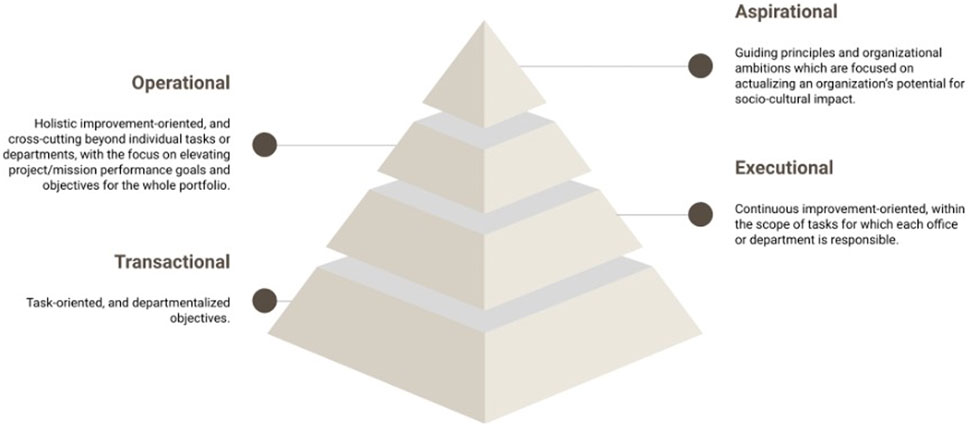
Figure 1. Value Hierarchy. Adapted from Bernstein (2018).
CBP operates within a hierarchy from broad aspirational goals to specific transactional tasks though rarely labeled as such. This hierarchy is illustrated in Figure 2. Establishing a “strategic goal,” or set of related goals, is based on (typically) lengthy deliberative processes of multiple stakeholders and inputs. As an organization defines a broad strategic goal, it follows that a set of functional domains of critical tasks and overall operation in support of the goal must be defined, or in other words “mission areas.” Mission areas serve as identifiers of the core areas of work to be achieved to meet a strategic goal successfully. As strategic goals and mission areas are defined to provide structure to a CBP framework, the process itself is geared toward an organization’s personnel exercising their discretion and expertise in the development of effective operational solutions and providing support for decentralized implementation (or processes tailored toward a particular asset or set of assets).
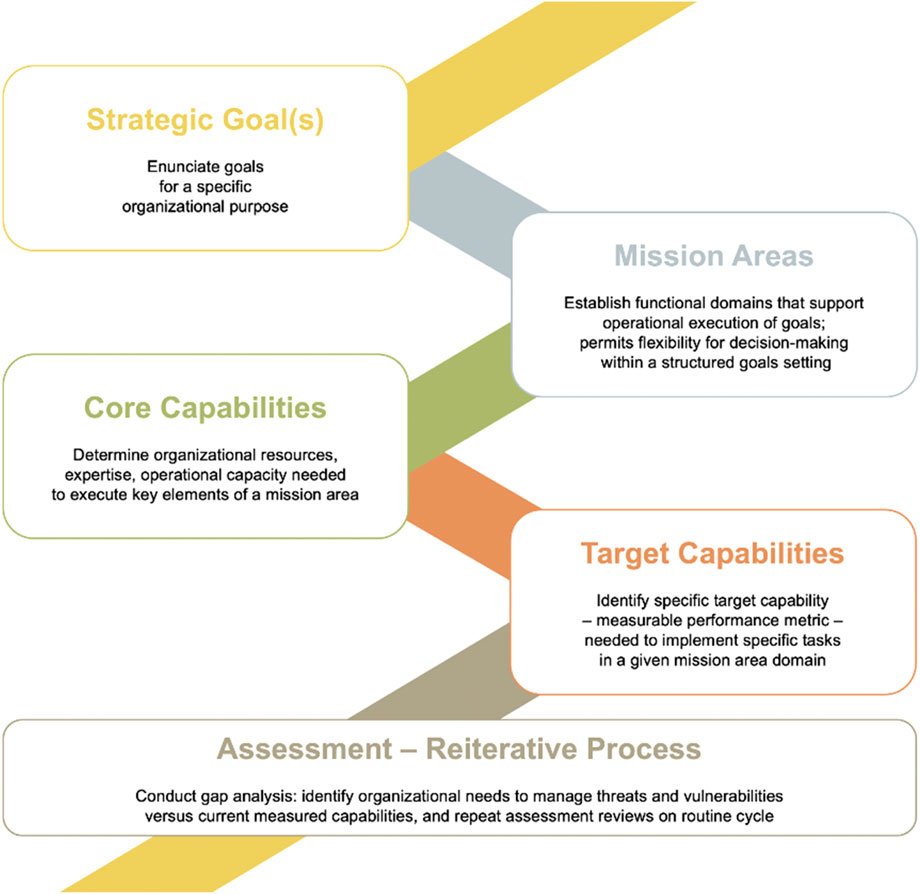
Figure 2. Simplified summary diagram of a CBP hierarchy. The diagram presents a simplified hierarchy, but this diagram does not convey the depth of the analysis required to implement the framework. In practice, each component requires a rather detailed set of decisions, data inputs, and stakeholder engagement.
Organizational mission areas manifest as “core capabilities,” which are the distinct elements necessary to execute a defined mission area to support a defined strategic goal(s). Core capabilities are executed by the joint or combined efforts of one or more units of an organization and other key stakeholders. Some core capabilities can, and typically do, exist across mission areas (e.g., planning).
Measurable “target capabilities” should be established to understand what an organization needs to execute its core capabilities at specified performance levels. Target capabilities serve as a basis for measuring organizational performance and the ability to accomplish goals and objectives in a defined mission area. These target capabilities should range from transactional to aspirational actions, as found in the Value Hierarchy. Then, under a given risk scenario, a gap assessment between the aspirational and actual performance of target capabilities reveals vulnerabilities and determines the need for additional resources to maintain capabilities. The gap analysis’ utility for strategic resource allocation decisions and other organizational adjustments makes it an indispensable tool for updating the process on a routine schedule.
2.2 Development of CBP process for OBO
The Department of State Bureau of Overseas Buildings Operations manages facilities that represent the U.S. government to the host nation and support U.S. foreign policy worldwide. Embassy 2050 is an OBO effort to engage academics and industry professionals to research the aforementioned global drivers of change that impact the built environment, diplomatic platforms, and tenant operations. OBO has a large portfolio, managing a total of 26,824 assets, including 921 office buildings and 17,290 residences. Approximately 83% of these assets are leased, with the remainder being owned by the government. Across these assets, there are 600+ active projects with a 37-billion-dollar value. OBO has a total portfolio valued at 83.2 billion dollars. Due to its large global and economic presence, OBO sets worldwide priorities for the design, construction, acquisition, maintenance, use, and sale of real properties and the use of sales proceeds.
The use of a capabilities-based planning (CBP) process could support OBO’s goal of building resilience capacity, and the related need to reduce risk across a range of potential hazards or other disruptions associated with global drivers (defined as population, urbanization, resources, technology, and climate). A CBP process provides a structure for OBO to define the critical capabilities necessary to create resilient assets as well as operational and administrative systems–once key drivers of change, and associated hazards and risks, are identified and placed in proper context. Moreover, a CBP process can be conducted routinely to review what gaps might be present for specific performance capabilities at a given point in time. The process also includes the purposeful definition of data capabilities and how they cut across key mission areas at OBO, as well as identification and planning on how to utilize emerging technologies that are useful in addressing drivers of change. More specifically, an organization seeking to adopt CBP would need to consider the following tasks: 1) adoption decision; 2) scope definition; 3) lead implementing unit and supporting unit definition; 4) review goal and mission area definitions; 5) establish hazards, threat, vulnerability, and available technology assessment guidelines and specification; 6) conduct final risk assessment guidelines and specification; 7) create core and target capabilities assessment processes; 8) define gap analysis review objectives and processes; 9) define the current state of data requirements for various processes stages; 10) create data and technology requirements and integration team for ongoing updates of said requirements; and 11) define a schedule for periodic reiteration of the CBP processes and assessment with a formal planning guide.
A multi-method approach--combining research charrettes, subject matter expert (SME) interviews, and document analysis--served to gather diverse perspectives and information relative to the specific challenges and opportunities within the OBO organization to develop a risk reduction and resilience framework through the CBP process. This process required several key steps, summarized as follows: First, a CBP process requires the enunciation of a strategic goal. In this case, the Embassy 2050 effort indicated the centrality of building resilience capacity at OBO, for both physical assets and administrative processes. Second, the OBO Embassy 2050 initiative also identifies and enunciates a set of global drivers, which both set a planning context, but also point to possible hazards and risks that must be addressed and managed. These scoping discussions occurred within the Embassy 2050 team before the research team’s engagement. Third, mission areas relevant to OBO’s strategic emphasis on resilience–and mission areas aligned with the building life cycle management needs central to OBO’s work-have to be identified and defined. As illustrated below, the CBP process identifies six mission areas that correspond with asset life cycles: (1) Asset Acquisition and Disposal, (2) Long Range Planning, (3) Architecture & Engineering, (4) Construction Management, and (5) Facilities Management/Operations. Fourth, core capabilities and target capabilities that follow from the mission areas also must be identified and defined in service of conducting gap analysis. Fifth, the CBP employed here must account for long-term strategic thinking and assessment. OBO’s focus is on change management and a strategy of building long-term resilience capacity. Sixth, and finally, the framework must be specific about data acquisition and utilization processes, which are complex because of the need for both local site-specific applications and identification of broader global trends.
The remainder of this section describes how these steps were informed by the subject matter expert interviews and research charrettes. Each step was further validated through document analysis from previous reports and studies completed by OBO. The following section describes the product alongside an application-based case study to demonstrate the use of the resulting framework within OBO operations.
2.2.1 Subject matter expert interviews
Semi-structured interviews are a qualitative research methodology that explores participants’ experiences and perspectives on a specific topic, and this approach allows emphasis to be placed on the participant rather than the interviewer (Jamshed, 2014). The research team conducted 12 virtual subject matter expert (SME) interviews with participants from Facility Assets, Operations & Management, Planning & Real Estate, Strategic Planning, Asset Management, Design & Engineering, and Master Planning from OBO. Each SME interview session lasted approximately 60 min and included one to three SMEs and two to five research team members, with two research team members alternating with facilitation responsibility. A Miro board was used to provide information to the SMEs as well as elicit feedback. SMEs were encouraged to write notes on the board directly, in addition to the research team member keeping notes. The interviews started with the participants describing their role(s) and responsibilities and what life-cycle stage it contributes. These subject matter interviews then aimed to introduce the participants to the initial draft capabilities-based planning framework for risk and resilience management and co-develop the framework through practice-oriented feedback. The interviews were held in a semi-structured format and primarily served to provide more in-depth knowledge on core and target capabilities; however, feedback was welcomed on the entire framework. The latest version of the framework would be introduced, and then the participants would be asked for feedback. The following instructions were provided at the start of each interview:
Review the life-cycle stages that you are most familiar with [in the framework]. Consider what will need to be in place during the life-cycle stage to manage risks. Risks management is divided into five phases–make sure to review all of them.
Then, the following prompts were provided: (a) Is this core capability needed? (b) What would be examples of specific target capabilities? (c) How can we integrate the drivers?
Iterations upon the framework in conjunction with the subject matter experts resulted in the proposed Risk Reduction and Resilience (R3) Framework. For instance, the five strategic goals identified in the framework were selected based on OBO’s doctrine (organizational values of security, resilience, and stewardship) and feedback (leading to the identification of risk mitigation and adaptation). The SME interviews primarily focused on the validation of the core capabilities–whether adding or removing core capabilities, clarifying definitions, refining the spectrum of relevant mission areas per core capability, identifying target capabilities, etc. Additionally, the SME interviews offered an opportunity to educate the research team on transactional to aspirational tasks within OBO, which was critically important for revising the mission areas and core capabilities, and identifying target capabilities for an organizational change scenario that will increase OBO’s incorporation of resilience and climate change adaptation practices.
2.2.2 Research charrettes
Research charrettes are structured workshops that enable respondent data collection and expert feedback in a short period of time, merging the functional characteristics of surveys, interviews, and focus groups into one setting. Remote research charrettes are the most recent version of this method, where the workshops are performed remotely via teleconferencing platforms (Gibson et al., 2022). The charrettes conducted as part of this study had three main objectives:
● Introduce participants to the proposed R3 Framework and demonstrate examples of application;
● Invite participants to individually assess the process, considering an anchor project in order to identify applicable core capabilities within each life cycle phase of their project; and
● Co-develop the R3 Framework and provide practice-oriented feedback that is applicable and effective for OBO decisions.
The research team (nine facilitating members) hosted a half-day, remote research charrette with attendees from OBO and a partnering architecture firm, Studio Ma. All interview participants were invited – 10 of the 14 were able to attend the research charrette. The session took 3 hours and resulted in 14 written responses from a diverse and experienced group of professionals: 64% from government, 21% from academia, 7% from consulting, and 7% from other (e.g., government-embedded contractors). Further, 36% of respondents had 21–25 years of experience, followed by 29% with over 25 years, 14% with 11–15 years and 16–20 years, and 7% with less than 5 years. The participants held different roles, and the top four roles were in engineering and construction (33%), management (17%), planning (17%), and architecture (11%).
The participants were reminded to keep an overarching vision in mind throughout the research charrette: What do we want our facilities to be in the face of (intersecting) global drivers in 2050? Participants were asked open-ended questions through Qualtrics to identify applicable core capabilities for OBO assets. The individuals were asked to answer the questions based on their own experience and an “anchor” project of their choice. In this case, an anchor project is an OBO asset that the participant is intimately familiar with. The anchor project helped provide context for a practical scenario for the participants. The participants then answered the questions individually via Qualtrics, and then the participants were also permitted to discuss their thoughts aloud. The questions were as follows: (1) From the perspective of your own specific expertise and areas of responsibilities, what are the critical tasks and key capabilities needed to reduce risk and build resilience; (2) For this [life-cycle stage], what are the key data needs to provide evidence-based decision-making and reasonable forecasting for issues related to the global drivers; and (3) Do you have any other comments or recommendations for addressing the five drivers in [this life-cycle stage]. These questions were repeated for each life-cycle stage. Participants were also prompted to provide comments on any gaps and/or areas for improvement for the overall framework at the end of the charrette. Through this process, the participants (a) reviewed the asset life cycle (i.e., determining the mission areas) and (b) identified expertise, tasks, responsibilities, and capabilities that would need to be in place during each phase to manage risk and resilience related to the global drivers (i.e., suggesting core and target capabilities).
3 Results
Capabilities-based planning (CBP) offers an effective, analytical structure for assessing short and long-term vulnerabilities under one or more risk scenarios. It provides a process for identifying and focusing efforts on resilience capacity building within an organization, specifically OBO for this case study. Five strategic goals were identified: security, resilience, stewardship, risk mitigation, and adaptation. Three of these strategic goals are already coded within OBO’s culture. The five identified mission areas (long-range planning, asset acquisition and transition, architecture and engineering, construction management, and facilities management and operations) are closely related to the basic logic of an asset’s life cycle. They also serve the purpose of linking the five strategic goals to specific core and target capabilities.
Initial core and target capabilities were identified to support the strategic goals and mission areas. The research team developed an initial draft of core capabilities by assessing existing OBO doctrine and guidance (e.g., the Embassy 2050 effort). However, the knowledge co-production efforts create a space to revise these core capabilities and develop target capabilities. Collectively, the research charrettes and interviews produced a revised CBP process consisting of five mission areas, 24 core capabilities (with four spanning all mission areas), and more than 33 target capabilities in support of the five strategic goals. The subject matter experts and research charrette participants (of which there was significant overlap) identified the following concepts as critical toward risk and resilience management: identification of global drivers’ patterns and trends, understanding the capacity of host nations and how to best support, understanding plans and management of surrounding developments, and ensuring security. More specifically, these ideas include: urbanization, immigration, and population trends and forecasts; natural hazards planning and identification; innovative project delivery methods; natural resources availability; material availability and local labor availability; input from local jurisdictions and the local community; information about the site itself; infrastructure development, including transit planning; logistics and supply chain management; security plans, including physical security and cybersecurity; and utilities’ data as well as using sensors to measuring building data. A more detailed summary of critical tasks and capabilities needed to reduce risk and build resilience in each mission area as identified during the charrette may be found in Table 1. The overall resulting initial product–titled the “Risk Reduction and Resilience (R3) Framework” – is presented in Figure 3. Detailed definitions of the mission areas and core capabilities may be found in Supplementary Appendix A. The Supplementary Material do not house target capabilities because these are context-dependent, meaning the target capabilities presented in this study are not exhaustive. The illustrative case study presents a water security scenario (i.e., context) and relevant target capabilities (Table 2), which sufficiently describes the functional purpose of target capabilities.
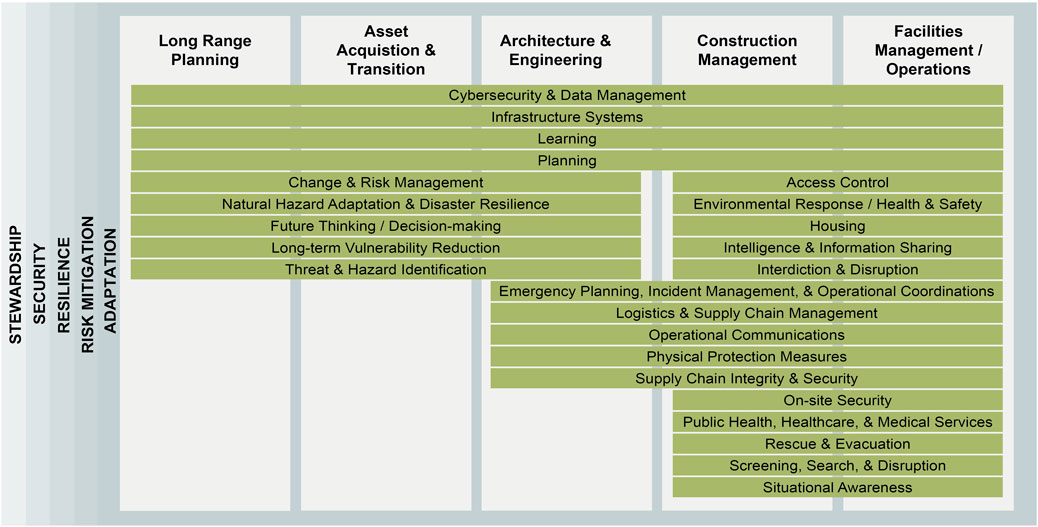
Figure 3. Risk Reduction and Resilience (R3) Framework. There are three main components depicted in the overview figure of the R3 framework: strategic goals (represented as the blue boxes along the left-hand side), mission areas (represented by the tan columns), and core capabilities (represented as the green boxes).
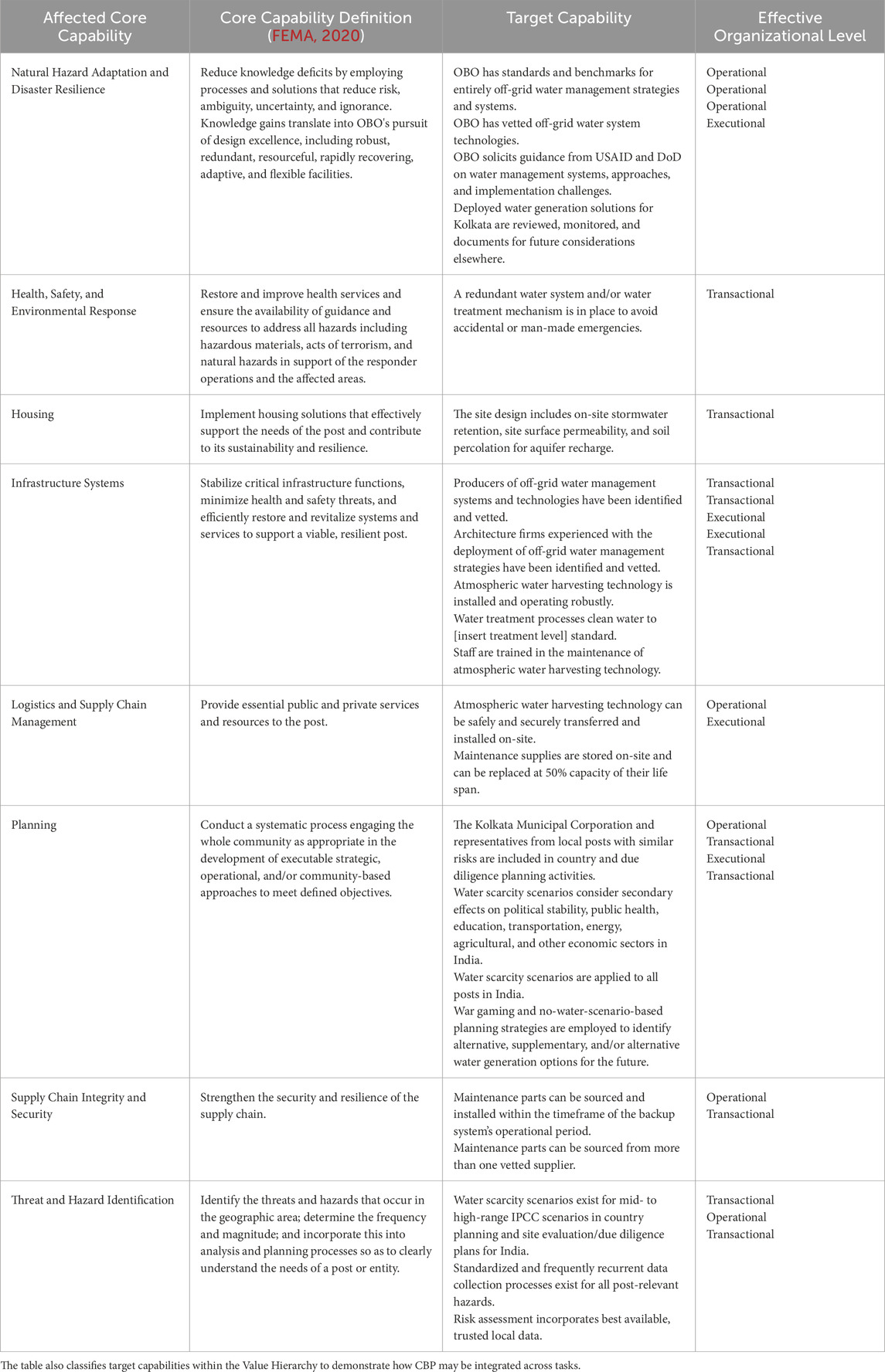
Table 2. Descriptions of affected core capabilities and proposed target capabilities for water security in Kolkata, India planning scenario.
3.1 Framework application via scenario planning: water security in Kolkata, India
Kolkata is a megacity within the Republic of India in the West Bengal state. The megacity of 14 million residents experiences a tropical savanna climate at an average elevation of 8 m above mean sea level (Census Organization of India, 2011; Dasgupta et al., 2013). Kolkata is India’s oldest metropolitan area and the 14th largest city in the world and third largest urban metropolitan area in India as of 2019 (Haque et al., 2019). Similar to many of the megacities in the Indian subcontinent, Kolkata has experienced unprecedented business and population growth, leading to a shift in lifestyle preferences and land use. This rapid urbanization has also led to an increase in pollutants [e.g., NOx, particulates, VOC, CO2, etc. (Majumdar et al., 2020)], which have significant consequences on residents’ health (e.g., high respiratory disease rates) and local ecology [e.g., loss of wetlands and urban heat island effect (Ghosh et al., 2021a)]. The municipal water supply system in Kolkata, for example, faces a cascading array of critical water stress challenges (Mukherjee et al., 2018), including drastic depletion of local groundwater due to industrialization (Sharma et al., 2021); subsidence and related infrastructure damage (Bose et al., 2020); inadequate purified municipal supply requiring many communities to install and rely on hand-pump wells and tube wells (Bhattacharya, 2013); persistent pollutants from industrial waste (Chatterjee et al., 1993) and human waste (Pujari et al., 2012); extensive arsenic contamination of direct-use groundwater (Chakraborti et al., 2017); and bacterial contamination in the Adi Ganga river (Ghosh et al., 2021b). A fault tree analysis diagram for water security in Kolkata, India is illustrated in Figure 4 to demonstrate a planning scenario. The diagram presents vulnerabilities that could lead to disruption at a diplomatic facility and links this to global drivers of concern to OBO.
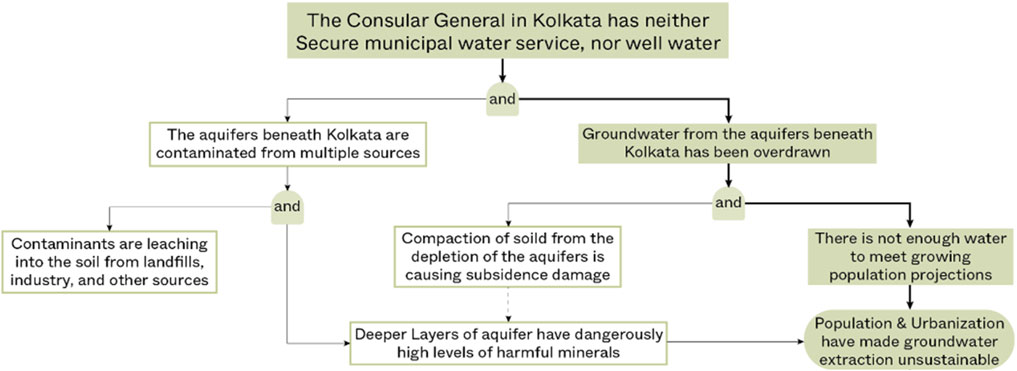
Figure 4. Fault tree analysis diagram for water security in Kolkata, India planning scenario, identifying faults and causes (rectangles) and root causes as related to the global drivers (oval).
Water security is a top concern of OBO across assets and projects in its portfolio, including its assets in Kolkata, India; thus, this site was selected to demonstrate the application of the R3 Framework. The case study provides a practical example for OBO to refine the CBP process and its specific R3 Framework. Therefore, the core and target capabilities presented here are a starting point. Based on severe water stress and rapid groundwater extraction scenario applied to the asset in Kolkata, eight core capabilities are likely to be significantly impacted within this scenario and, therefore, prime candidates for developing target capabilities to reduce risk and impacts (Figure 5). To increase the resilience of the asset and its operations, 22 target capabilities are proposed across the eight core capabilities (Table 2). For instance, for OBO to confidently sustain operations in the megacity of Kolkata, alternative source(s) of on-site water generation, which draw neither from surface water nor groundwater, should be pursued as a critical target capability with Kolkata’s degrading environmental air quality in consideration. Additional target capabilities for this planning scenario may include: sharing performance research reports with local and national governmental partners; demonstrating emergent, and preferably local, technology to diplomatic visitors; and data collection of water quantity and quality to inform management of assets experiencing similar challenges. It is important to note that the implementation and/or path toward these target capabilities may have co-benefits or adverse effects for other core capabilities and associated target capabilities, which are not listed here.
4 Discussion
The R3 Framework, via capabilities-based planning, is a process aimed at identifying threats, hazards, vulnerability, and risk; placing that information in context; establishing whether an organization is capable at present of meeting risk and resilience targets; and making resources and management decisions according to that overall assessment. This article outlines the process for developing a capabilities-based planning framework for risk reduction and resilience for organizations with large physical asset or infrastructure projects. The five actions that allowed for the development of this framework were: 1) defining the strategic goals; 2) establishing mission areas; 3) identifying hazards, threats, or change; 4) identifying vulnerabilities to those hazards/threats/changes; 4) describing core capabilities; and 5) defining target capabilities as a performance measurement. This should be an iterative process where each step is reviewed and reassessed. The R3 Framework provides an effective structure for assessing short and long-term risk and a process to identify and focus efforts on resilience capacity building. Three key benefits emerge from the development of the R3 Framework: a) permits a systematic review of need and response, providing an opportunity to identify key risks and build capabilities; b) integrates across departments and divisions within an organization and across scales from a project to portfolio level; and c) complements existing processes rather than supplants, enhancing organizational efficacy. Capabilities-based planning, more broadly, builds institutional capacity to recognize, address, and respond to growing complexity in managing risk over a range of interdependent threats and hazards, typically with a high level of associated uncertainties, by holistically reviewing decision spaces and feasible actions.
There are still limitations to adopting such a framework, and systematic planning requires a well-developed process, non-trivial data inputs, and significant levels of participation by a wide range of agency personnel. Hence, the remainder of this discussion focuses on this limitation and explores future research pathways along the intersection of complexity, emergent technologies, and the implementation of capability-based planning processes. Two components that are essential to the successful implementation of a CBP process, particularly to address asset-level target capabilities: 1) adoption of computational tools to support multi-stakeholder collaboration across scales and life cycle timelines and 2) introduction of innovative project delivery methods for aligning stakeholders around project-level core and target capabilities early in the process. Computational tools for complexity aligned with innovative project delivery methods should serve as one critical ‘bookend’ to successfully center and track coordination around the critical target capabilities specific to the needs of each project (Figure 6).
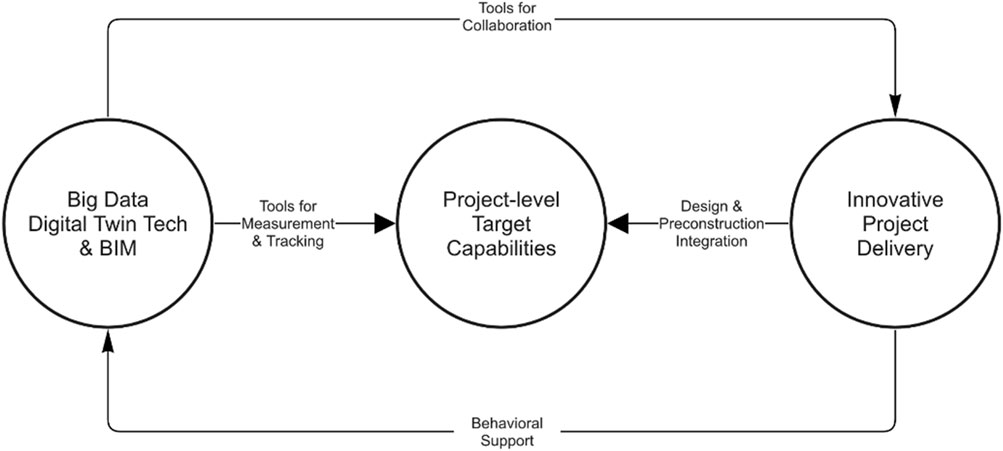
Figure 6. A diagram illustrating the “bookending” of capabilities-based planning with computational tools for complexity and innovative project delivery.
4.1 Adopting computation tools for complexity
An organizational-wide strategy, considering operational and administrative systems and behavioral support, and computational tools for complexity will be necessary to engage CBP across diverse temporal and spatial scales. The design process for a single asset requires a collaborative decision-making process across multiple criteria for that asset’s intended performance outcomes. Emergent computational tools for managing complexity will be a critical component toward collaboratively establishing and tracking an asset’s target capabilities throughout the diplomatic facility life cycle. For instance, data-rich building information modeling (BIM) tools have been broadly and globally adopted over the last decade, becoming the architecture, engineering, and construction industry standard for stakeholder collaboration around building design, construction, and operations. Khan and Hornbæk (2011) have outlined the challenges emerging from the need to aggregate and visualize massive quantities of big data across the built environment–in other words, a small problem with a lot of data is a big problem.
Novel technologies, including artificial intelligence (AI) driven software, are also in emergent states of development as tools that demonstrate the potential to help organizations explore and evaluate large numbers of interrelated, data-driven decisions and solutions. Much like building information modeling has been broadly adopted into the architecture, engineering, and construction industry standards of practice, integration of big data, AI, and digital twin technologies is anticipated to be broadly and globally adopted throughout the built environment as well. Digital twin (DT) technologies combine digital models (often BIM) and environment data (e.g., water, transportation, real estate models, etc.) for anticipatory simulation and real-time monitoring of the performance of physically constructed assets and systems (the physical twin). DT technology allows an organization to monitor real-time performance goals remotely, practice disturbance response and management through simulation, and more easily communicate needs (with the help of visualization) internally and to external stakeholders. This adoption and integration could be highly valuable for an organization towards complex, multi-stakeholder decision-making processes for risk reduction and resilience capacity, but will also present challenges in initial capital costs, cybersecurity, and coordination of cross-cutting operations (Figure 7).
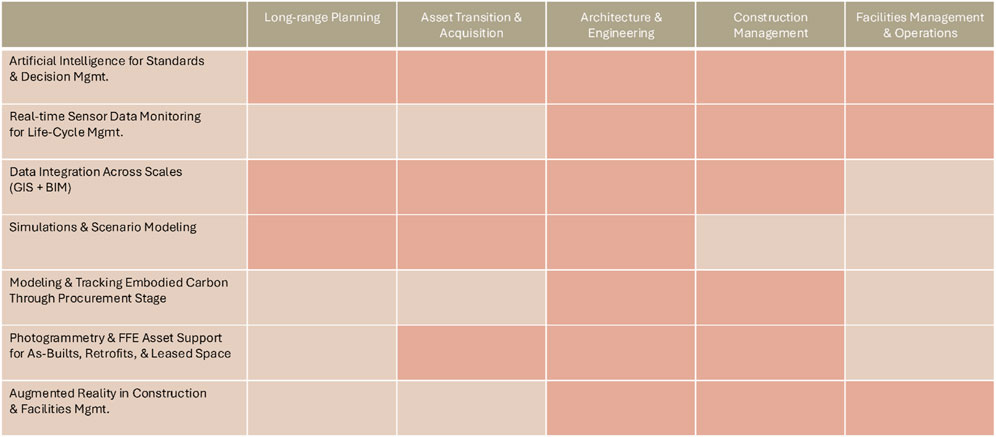
Figure 7. Diagram illustrating vertical integration of a building Digital Twin (DT), both down to DTs of building systems, as well as up to a DT of the city where the building is located (Lu et al., 2020). Dark peach indicates the relevance of the technology to a particular stage of the life cycle.
4.2 Innovating project delivery methods and contract structuring
The efficacy of capabilities-based planning (CBP) in promoting risk reduction and resilience, as a feature of new asset delivery, is challenged by the need for stakeholders to be engaged earlier and consistently throughout the project delivery process. Increased stakeholder engagement is costly in terms of organizational time and resource commitment. However, the value is that it will provide opportunities to innovate around project delivery, while also helping incentivize the needed performance outcomes and behaviors–most notably collaboration and transparency–to achieve core and target capabilities goals. In simple terms, core and target capabilities must proactively inform planning, design, and construction choices from the onset in addition to proactively and retroactively monitoring risk reduction and resilience capacity during the asset’s lifespan.
A number of project delivery methods are at the disposal of organizations, including the traditional design-bid-build method, as well as more collaborative integrated approaches such as construction manager at risk, design-build, progressive design-build, and integrated project delivery. Using the traditional method does not allow (nor incentivize) various key stakeholders to engage early in the project as collaborators to help present innovative, capabilities-focused solutions. Instead, traditional project delivery methods can be understood as treating construction as a commodity, only engaging the builders after key design decisions have been completed and codified within the project (El Asmar and Assainar, 2017). This can often lead to coordination and logistics challenges, longer schedules, compromise relative to (sometimes critical) capabilities outcomes, and other missed project opportunities. Innovative project delivery methods can positively impact project cost and functional capabilities as seen in Figure 8, which demonstrates how more positive outcomes can be integrated into a design solution and extra costs minimized when design decisions are integrated earlier in the project timeline (American Institute of Architects, 2007). Within innovative delivery methods, the builder is engaged early to inform the design while it is ongoing, providing their expertise and real-time cost (including for labor and materials) and schedule estimating to understand the impacts of various design decisions (Papajohn et al., 2019; 2020; Bingham et al., 2019; Alleman et al., 2017). These methods generally lead to more integration and innovation, significantly faster schedules, and other performance benefits (El Asmar, 2012; Feghaly et al., 2021). Efficiencies can be significantly improved using such delivery methods.
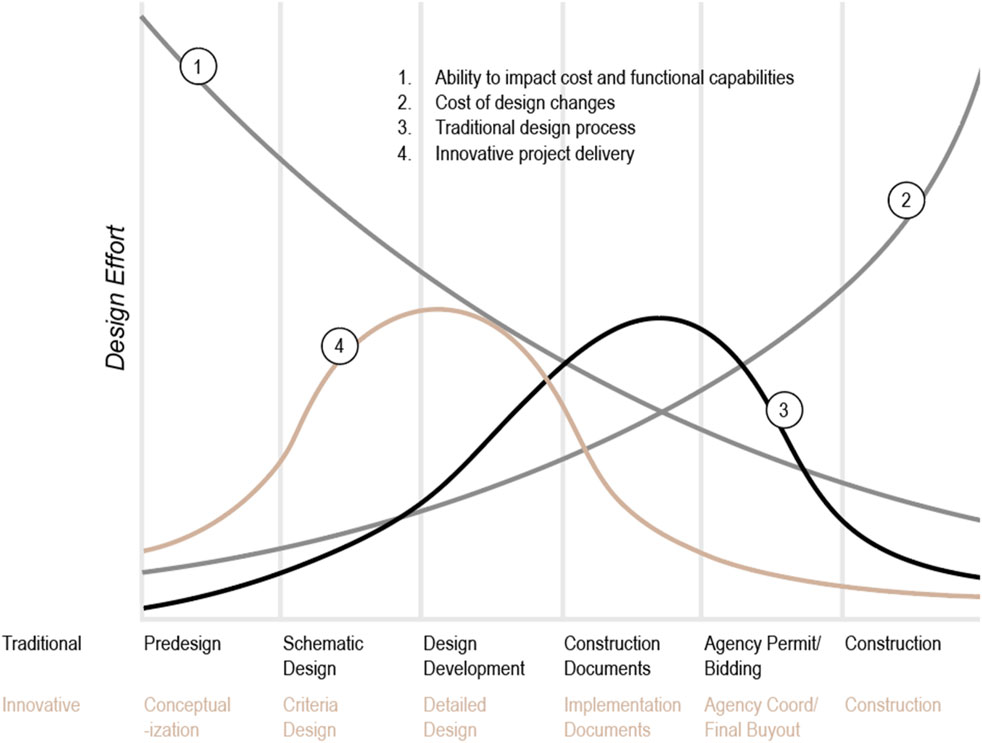
Figure 8. Modified version of the MacLeamy Curve. First introduced in the Construction Users Roundtable’s “Collaboration, Integrated Information, and the Project Lifecycle in Building Design and Construction and Operation” (American Institute of Architects, 2007). Line one (grey) demonstrates that increased design effort at the early stages of a project can have the largest impact on cost and functional capabilities. Line two (grey) demonstrates that costs of design changes increases if those changes are suggested in later project stages. Line three (black) displays the typical timeline for the engagement of designers in traditional project delivery methods; these project stages are listed in black along the x-axis. Line four (tan) displays the typical timeline for the engagement of designers in innovative project delivery methods; these project stages are listed in tan along the x-axis.
Given that the design still needs to be completed when the contractor is engaged in innovative project delivery, the contractor needs to be selected based, at least in part, on their prior experiences, understanding of the challenges of the particular project, and their unique qualifications. Through a qualifications-based competition for procurement, a contractor would be selected based on their potential to integrate core capabilities into the design and construction of the facility. Imagine an organization engaging contractors on how they plan to address the global drivers on a particular project, engaging CBP in the earliest stages of the asset’s life cycle. Moreover, an organization could consider tying design and construction fees to their identified target capabilities, and including additional services related to computational tools for complexity in the contractor selection process and construction contract. Departure from traditional project delivery methods provides significantly more opportunities for innovation, as has been proven in many construction sectors over the past decade (Feghaly et al., 2019; Chester et al., 2021).
5 Conclusion
The massive change in the world, catalyzed by key global drivers discussed here, will require a fundamental change in the ways that individuals, organizations, and institutions operate within and inhabit the world. Organizations with large portfolios of physical assets and critical infrastructure projects, such as the case of OBO’s responsibilities within the U.S. State Department, encounter a significant challenge to address these drivers and changes across diverse assets in a way that strategically manages risk and resilience as needed for each asset. A capabilities-based planning (CBP) process has been explained here to show how similar organizational settings might navigate such sustained challenges and chronic risk and vulnerability. The case study demonstrates a pathway for CBP to provide measurable and structured responses to risk and resilience while balancing short-term and long-term outcomes across transactional and aspirational organizational tasks. Moving forward, emphasis on needs and opportunities for organizational change, including the proactive procedural challenges of adopting and implementing emerging computational tools for complexity, is critical to building resilience capacity within organizations. These tools and the internal and external agents needed to implement and maintain them, will both provide access to growing lakes of big data and methods for complex decision-making across the built environment, while also introducing a number of valid and challenging concerns for the future of data security and cybersecurity.
Data availability statement
The original contributions presented in the study are included in the article/Supplementary Material, further inquiries can be directed to the corresponding author/s.
Ethics statement
Ethical review and approval was not required for the study on human participants in accordance with the local legislation and institutional requirements. Written informed consent from the [patients/ participants OR patients/participants legal guardian/next of kin] was not required to participate in this study in accordance with the national legislation and the institutional requirements.
Author contributions
AH: Writing–original draft, Writing–review and editing. BG: Writing–original draft, Writing–review and editing. MG: Writing–original draft, Writing–review and editing. PH: Writing–original draft, Writing–review and editing. MA: Writing–original draft, Writing–review and editing. DS: Writing–original draft, Writing–review and editing. MN: Writing–original draft, Writing–review and editing. RE: Writing–original draft, Writing–review and editing. HS: Writing–original draft, Writing–review and editing. AV: Writing–original draft, Writing–review and editing. YY: Writing–original draft, Writing–review and editing. DW: Writing–original draft, Writing–review and editing.
Funding
The author(s) declare that financial support was received for the research and/or publication of this article. This work was supported by the U.S. Department of State (#19AQMM19D00072), Global Futures Laboratory Projects for Embassy 2050 Innovation for Security, Resilience, and Sustainable Operations. We would also like to thank Mikhail Chester; the Office of Overseas Buildings Operations and the Embassy 2050 team; Studio Ma; and the 91 ASU design studio M.Arch. students for their work in support of this research.
Acknowledgments
This article reflects the priorities of the administration in power at the time of writing, which have since changed under the current administration.
Conflict of interest
The authors declare that the research was conducted in the absence of any commercial or financial relationships that could be construed as a potential conflict of interest.
Generative AI statement
The author(s) declare that no Generative AI was used in the creation of this manuscript.
Publisher’s note
All claims expressed in this article are solely those of the authors and do not necessarily represent those of their affiliated organizations, or those of the publisher, the editors and the reviewers. Any product that may be evaluated in this article, or claim that may be made by its manufacturer, is not guaranteed or endorsed by the publisher.
Supplementary material
The Supplementary Material for this article can be found online at: https://www.frontiersin.org/articles/10.3389/fbuil.2025.1530343/full#supplementary-material
References
Adger, W. N. (2006). Vulnerability. Glob. Environ. Change 16 (3), 268–281. doi:10.1016/j.gloenvcha.2006.02.006
Alleman, D., Papajohn, D., Gransberg, D. D., El Asmar, M., and Molenaar, K. R. (2017). Exploration of early work packaging in construction manager–general contractor highway projects. Transp. Res. Rec. 2630 (1), 68–75. doi:10.3141/2630-09
American Institute of Architects (AIA) (2007). Integrated project delivery: a guide. Available online at: https://www.aia.org/resources/64146-integrated-project-delivery-a-guide.
Bernstein, P. (2018). Architecture | design | data: practice competency in the Era of computation. Switzerland: Birkhauser. doi:10.1515/9783035610444
Bhattacharya, A. K. (2013). An analysis of land subsidence in Bangkok and Kolkata due to over-extraction of groundwater. Electron. J. Geotechnical Eng. 18, 1683–1694.
Bingham, E., Gibson Jr, G. E., and El Asmar, M. (2019). Identifying team selection and alignment factors by delivery method for transportation projects. J. Constr. Eng. Manag. 145 (10), 04019061. doi:10.1061/(asce)co.1943-7862.0001704
Bose, S., Mazumdar, A., and Basu, S. (2020). “Review on present Situation of groundwater scenario on Kolkata municipal area,” 505. IOP Publishing. In IOP Conference Series: Earth and Environmental Science. doi:10.1088/1755-1315/505/1/012022012022
Bradley, D. J. (2018). Applying the THIRA to special events: a framework for capabilities-based planning adoption in local governments. United States: NAVAL POSTGRADUATE SCHOOL MONTEREY CA MONTEREY.
Caudle, S. (2005). Homeland security capabilities-based planning: Lessons from the defense community. Homel. Secur. Aff. Available online at: https://www.hsaj.org/articles/178.
Census Organization of India (2011). Kolkata city population 2011. Available online at: https://www.census2011.co.in/census/city/215-kolkata.html.
Chakraborti, D., Das, B., Rahman, M. M., Nayak, B., Pal, A., Sengupta, M. K., et al. (2017). Arsenic in groundwater of the Kolkata Municipal Corporation (KMC), India: critical review and modes of mitigation. Chemosphere 180, 437–447. doi:10.1016/j.chemosphere.2017.04.051
Chatterjee, A., Das, D., and Chakraborti, D. (1993). A study of ground water contamination by arsenic in the residential area of Behala, Calcutta due to industrial pollution. Environ. Pollut. 80 (1), 57–65. doi:10.1016/0269-7491(93)90010-l
Chester, M., and Allenby, B. (2022). Infrastructure autopoiesis: requisite variety to engage complexity. Environ. Res. Infrastructure Sustain. 2 (1), 012001. doi:10.1088/2634-4505/AC4B48
Chester, M., El Asmar, M., Hayes, S., and Desha, C. (2021). Post-disaster infrastructure delivery for resilience. Sustainability 13 (6), 3458. doi:10.3390/su13063458
Chester, M., Markolf, M., and Allenby, B. (2019). Infrastructure and the environment in the Anthropocene. J. Industrial Ecol. 23 (5), 1006–1015. doi:10.1111/jiec.12848
Dasgupta, S., Gosain, A., Rao, S., Roy, S., and Sarraf, M. (2013). A megacity in a changing climate: the case of Kolkata. Clim. Change 116, 747–766. doi:10.1007/s10584-012-0516-3
Davis, P. K. (2002). Analytic architecture for capabilities-based planning, mission-system analysis, and Transformation. Santa Monica, CA: RAND Corporation. Available online at: https://www.rand.org/pubs/monograph_reports/MR1513.html.
El Asmar, M. (2012). Modeling and Benchmarking performance for the integrated project delivery(IPD) system. Diss. Abstr. Int. 74 (01).
El Asmar, M., and Assainar, R. (2017). Breaking with tradition: Quantifying the performance impact of nontraditional stakeholder involvement. J. Leg. Aff. Dispute Resolut. Eng. Constr. 9 (2), 04517001. doi:10.1061/(asce)la.1943-4170.0000211
Federal Emergency Management Agency (FEMA) (2020). Mission areas and core capabilities. Available online at: https://www.fema.gov/emergency-managers/national-preparedness/mission-core-capabilities.
Feghaly, J., El Asmar, M., Ariaratnam, S., and Bearup, W. (2019). Selecting project delivery methods for water treatment plants. Eng. Constr. Archit. Manag. 27, 936–951. doi:10.1108/ecam-06-2019-0308
Feghaly, J., El Asmar, M., and Ariaratnam, S. T. (2021). A comparison of project delivery method performance for water infrastructure capital projects. Can. J. Civ. Eng. 48 (6), 691–701. doi:10.1139/cjce-2019-0508
Fitzsimmons, M. (2007). Whither capabilities-based planning? NATIONAL DEFENSE UNIV WASHINGTON DC INST FOR NATIONAL STRATEGIC STUDIES.
Gerber, B. J. (2020). Understanding and analyzing natural hazards governance. In B. J. Gerber Ed. in Chief Oxford encyclopedia of natural hazard governance, (pp. xxxv-xlviii). New York, N.Y.: Oxford University Press.
Ghosh, S., Das Chatterjee, N., and Dinda, S. (2021a). Urban ecological security assessment and forecasting using integrated DEMATEL-ANP and CA-Markov models: a case study on Kolkata Metropolitan Area, India. Sustain. Cities Soc. 68, 102773. doi:10.1016/j.scs.2021.102773
Ghosh, S., Majumder, S., and Roychowdhury, T. (2021b). Impact of microbial multi-metal and broad spectrum antibiotic tolerance in urban SW (Adi Ganga, Kolkata) on adjacent groundwater: a future threat. Groundw. Sustain. Dev. 14, 100608. doi:10.1016/j.gsd.2021.100608
Gibson, G. E., Sanboskani, H., El Asmar, M., and Aramali, V. (2022). Employing technology to enable remote research charrettes as a method for engaging industry and Uncovering best practices: a Novel approach for a post-COVID-19 world. J. Constr. Eng. Manag. 148 (11). doi:10.1061/(asce)co.1943-7862.0002375
Haque, I., Mehta, S., and Kumar, A. (2019). “Towards sustainable and inclusive Cities: the case of Kolkata,” in ORF special report No. 83. Observer Research Foundation.
Helmrich, A., and Chester, M. (2022). Navigating Exploitative and Explorative Leadership in support of infrastructure resilience. Front. Sustain. Cities 4, 14. doi:10.3389/FRSC.2022.791474/BIBTEX
Hollnagel, E., Woods, D. D., and Leveson, N. (2006). Resilience engineering: concepts and precepts. Burlington, VT: Ashgate.
Jacob, B. (2020). The production of public goods, services and regulation for natural hazards. In B. J. Gerber Ed. in Chief Oxford encyclopedia of natural hazard governance, (pp. 100–110). New York, N.Y.: Oxford University Press.
Jamshed, S. (2014). Qualitative research method-interviewing and observation. J. Basic Clin. Pharm. 5 (4), 87. doi:10.4103/0976-0105.141942
Johnson, K. A., and Cain, W. (2010). Adaptation and application of federal capabilities-based planning models to individual states: state of Colorado case study. J. Homel. Secur. Emerg. Manag. 7 (1). doi:10.2202/1547-7355.1610
Khan, A., and Hornbæk, K. (2011). “Big data from the built environment,” in Proceedings of the 2nd international workshop on Research in the large, 29–32.
Lu, Q., Parlikad, A. K., Woodall, P., Ranasinghe, G. D., Xie, X., Liang, A., et al. (2020). Developing a digital twin at building and city levels: case study of West Cambridge campus. J. Manag. Eng. 36 (3), 05020004. doi:10.1061/(asce)me.1943-5479.0000763
Majumdar, D., Purohit, P., Bhanarkar, A. D., Rao, P. S., Rafaj, P., Amann, M., et al. (2020). Managing future air quality in megacities: Emission inventory and scenario analysis for the Kolkata Metropolitan City, India. Atmos. Environ. 222, 117135. doi:10.1016/j.atmosenv.2019.117135
Mukherjee, S., Bebermeier, W., and Schütt, B. (2018). An overview of the impacts of land use land cover changes (1980–2014) on urban water security of Kolkata. Land 7 (3), 91. doi:10.3390/land7030091
Papajohn, D., El Asmar, M., and Molenaar, K. R. (2019). Contract administration tools for design-build and construction manager/general contractor highway projects. J. Manag. Eng. 35 (6), 04019028. doi:10.1061/(asce)me.1943-5479.0000718
Papajohn, D., El Asmar, M., Molenaar, K. R., and Alleman, D. (2020). Comparing contract administration functions for alternative and traditional delivery of highway projects. J. Manag. Eng. 36 (1), 04019038. doi:10.1061/(asce)me.1943-5479.0000727
Pujari, P., Padmakar, C., Labhasetwar, P. K., Mahore, P., and Ganguly, A. K. (2012). Assessment of the impact of on-site sanitation systems on groundwater pollution in two diverse geological settings—a case study from India. Environ. Monit. Assess. 184 (1), 251–263. doi:10.1007/s10661-011-1965-2
Sharma, R., Kumar, R., Agrawal, P. R., and Gupta, G. (2021). “Groundwater extractions and climate change,”. Elsevier, 23–45. Water Conservation in the Era of Global Climate Change.
Steffen, W., Broadgate, W., Deutsch, L., Gaffney, O., and Ludwig, C. (2015). The trajectory of the Anthropocene: the Great acceleration. Anthropocene Rev. 2 (1), 81–98. doi:10.1177/2053019614564785
Taliaferro, A. C., Gonzalez, L. M., Tillman, M., Ghosh, P., Clarke, P., and Hinkle, W. (2019). Defense governance and management: Improving the defense management capabilities of foreign defense institutions-A guide to capability-based planning (CBP). INSTITUTE FOR DEFENSE ANALYSES ALEXANDRIA VA.
Twigg, J. (2004). Disaster risk reduction: mitigation and preparedness in development and emergency programming. United Kingdom: Overseas Development Institute ODI.
Tyszkiewicz, M. T., McCleskey, E. R., and Miller, R. (2012). Updating the national planning scenarios: using wicked problems and capability-based planning concepts for homeland security. J. Homel. Secur. Emerg. Manag. 9 (1). doi:10.1515/1547-7355.1903
Woods, D. D. (2015). Four concepts for resilience and the implications for the future of resilience engineering. Reliab. Eng. Syst. Saf. 141 (April 2015), 5–9. doi:10.1016/j.ress.2015.03.018
Keywords: capabilities-based planning, decision-making, complexity, resilience, risk reduction
Citation: Helmrich A, Gerber B, Gall M, Horton P, El Asmar M, Sailor D, Neveu M, El Kassis R, Sanboskani H, Vogel A, Yu Y and White D (2025) Developing long-term risk & resilience management strategies for physical asset and critical infrastructure projects. Front. Built Environ. 11:1530343. doi: 10.3389/fbuil.2025.1530343
Received: 18 November 2024; Accepted: 03 March 2025;
Published: 21 August 2025.
Edited by:
Tao Liu, Peking University, ChinaReviewed by:
Claudia Garrido Martins, University of New Mexico, United StatesWofai Ewa, Cross River University of Technology, Nigeria
Rajesh Kherde, D. Y. Patil University Pune Ambi, India
Adrian Iura, Lucian Blaga University of Sibiu, Romania
Michalis Papamichael, European University Cyprus, Cyprus
Copyright © 2025 Helmrich, Gerber, Gall, Horton, El Asmar, Sailor, Neveu, El Kassis, Sanboskani, Vogel, Yu and White. This is an open-access article distributed under the terms of the Creative Commons Attribution License (CC BY). The use, distribution or reproduction in other forums is permitted, provided the original author(s) and the copyright owner(s) are credited and that the original publication in this journal is cited, in accordance with accepted academic practice. No use, distribution or reproduction is permitted which does not comply with these terms.
*Correspondence: A. Helmrich, YWhlbG1yaWNoQHVnYS5lZHU=
 A. Helmrich
A. Helmrich B. Gerber
B. Gerber M. Gall
M. Gall P. Horton
P. Horton M. El Asmar4
M. El Asmar4 D. Sailor
D. Sailor H. Sanboskani
H. Sanboskani A. Vogel
A. Vogel Y. Yu
Y. Yu D. White
D. White